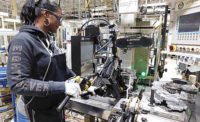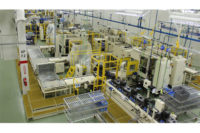In Greek mythology, Ariana was the daughter of King Minos. She fell in love with Theseus and helped him to escape the monster Minotaur, but was later abandoned by Theseus. Eventually she married the god Dionysus.
In Italian manufacturing, Ariana was the name of a pilot program implemented by Honda Italia in mid-2007 that used RFID tags to track the assembly process of Honda motorcycles. The company affixed passive 13.56 megahertz high-frequency (HF) tags to the motorcycles’ chassis and certain components to ensure that the proper components were installed on the appropriate frames.
Angelo Coletta, project manager for Honda Italia, says the manufacturer was happy with the tracking system. However, workers were bothered by the antennas that had been installed close to the production line to enable interrogation of the HF tags, which have a short read range. The workers also didn’t like that the RFID application required them to confirm that tags had been successfully interrogated during production.
To eliminate this extra step, and to move antennas farther from the production line, Honda Italia added ultra-wide band (UWB) active tags in April 2008 by launching a project called New Ariana. These tags, made by Ubisense Americas, help assure that the proper parts are built onto the right motorcycle frames. They also make it easy to track a specific motorcycle model, should it need to be recalled for safety repairs.
With New Ariana, Honda Italia places active and passive tags on the first and last containers of large parts used for its 60-unit runs. For example, tags are placed on the first and 60th containers of headlights. Active and passive tags are also placed on all containers of smaller parts, such as cables. These containers are tagged at the warehouse and then moved to the production facility.
During production, workers attach an active tag to each motorcycle chassis, and then use a handheld interrogator to save that bike’s VIN number onto the tag’s memory. As the chassis moves through each production position, employees add components. The active tag transmits its signal every second to 13 antennas surrounding the 262-foot-long production line, which has 38 individual stations where different production steps are performed.
The active tags allow assemblers to easily locate a particular container within the production zone. The passive tags are not interrogated in the production zone. They are used to store additional information (supplier code, part number, lot number, date of production, etc.) and link it to active tags via a database.
If managers suddenly opt to alter production to a different model, workers immediately know the whereabouts and status of each bike in production. When production begins on a new run, an assembler moves a tagged container of components to the production line. The container’s active tag is read automatically to confirm that it holds the correct components for the motorcycle being assembled. If the assembler attempts to bring the wrong active-tagged container, an alarm will sound.
At the end of the line, active tags are removed for reuse, and production information is stored. Honda Italia uses and re-uses about 300 active and 3,000 passive tags per year.
For more information on real-time locating systems, call 720-249-4149 or visit www.ubisense.net.
Honda Italia Shifts its RFID Deployment Into Second Gear

During production, workers attach an active tag to each motorcycle chassis. As the chassis moves through each production position, employees add components and the tag lets managers know exactly where the frame is on the production line.


